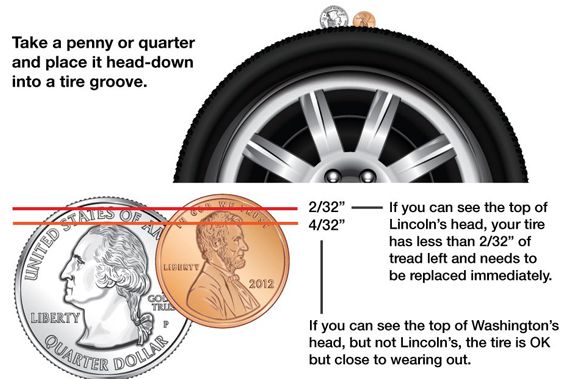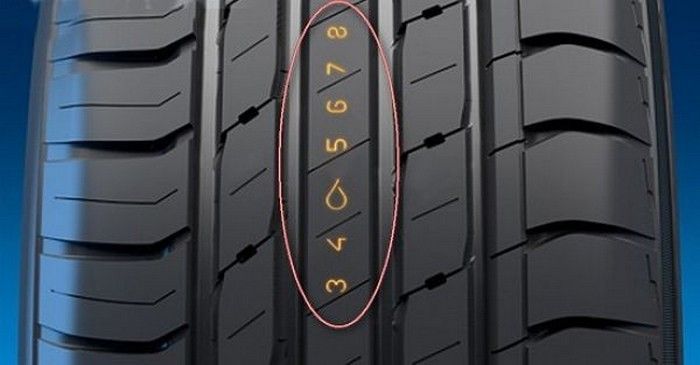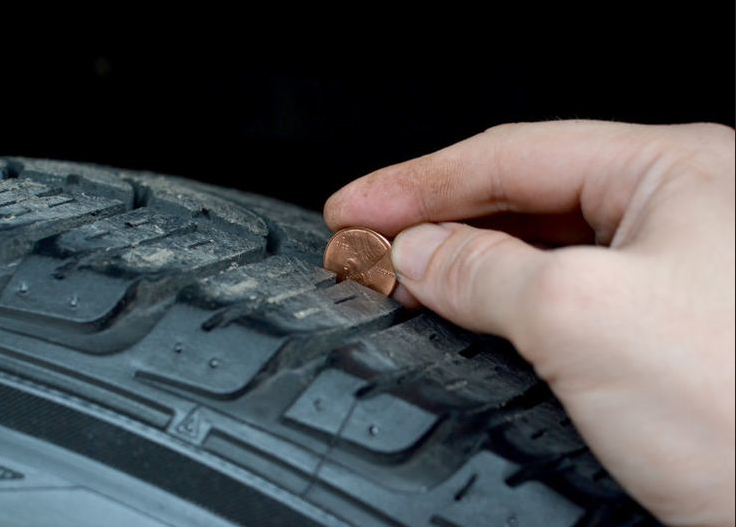The biggest problem with any car tire is the use time. The older the tire, the more unsafe it is. The problem is that over time, rubber tires will become stiffer and begin to crack. To determine when to replace car tires, tread depth is an important factor in tire function that you need to check. Let’s roll your sleeves and find out how to check the tire tread depth for your car.
Contents
What Is The Minimum Tire Tread Depth?
First, we will discuss the term “tire tread depth”. The tread depth is the vertical distance between the top of the tread rubber to the bottom of the deepest tread of the tire. Tire tread depth is measured in units of 1/32 of an inch (1 inch is divided into 32 units). With new tires, tread depth is usually 10/32 inches or 11/32 inches, and some truck, SUV, and winter tires may have a deeper tread depth than other models:

- Tire tread depth over 6/32″: your tires are in good functionality. 6/32″ is the minimum tread depth that we recommend for winter driving. It’s important to do more than just a quick visual check of your tire tread depth.
- If a tread depth of 5/32″ will interfere with wet driving, you should consider changing your tires.
- This indicator is from 3/32″ – 4/32″, you should change the tire as soon as possible.
- If it reaches 2/32″ you need to change the tire immediately.
You can refer to the tire depth chart below to know more:
| Tread depth – inch(mm) | Action |
| 11/32” (8.73) | Good |
| 10/32” (7.94) | Good |
| 9/32” (7.14) | Optimal |
| 8/32” (6.35) | Optimal |
| 7/32” (5.56) | OK |
| 6/32” (4.76) | Acceptable |
| 5/32” (3.97) | Acceptable |
| 4/32” (3.18) | Inspect tread depth regularly (change tires If possible) |
| 3/32” (2.38) | Change ASAP |
| 2/32” (1.66) and below | Replace right away |
The legal limit of wear is 1.6 mm or 2/32nds of an inch of tread depth. But most tire makers recommend tires be replaced before the legal limit of wear is reached to ensure better wet-weather stopping power. Besides, the law requires car tires to have a minimum tread depth of 1.6 mm in a continuous band around the central three-quarters of the tire. To help you judge how much tread you have on your car tires, manufacturers often mold tread bars at roughly 1.6 mm.
So we recommend that drivers need to change their tires when their tread depth is at 3/32″ – 4/32″. Because the tire’s performance will decrease before the tread reaches 2/32″. And your tires will be a hazard if the tread depth is at 2/32″.
>> Related post: Tire Speed Rating: What You Need to Know
How Important Is It To Check The Tread Depth?
The primary function of the tire tread is to divert water from beneath the tire to improve traction and avoid hydroplaning on wet roads. Over time tires wear down and this can affect your stopping distance dramatically so it’s really important to check your tire tread and replace them when required. Imagine you are traveling at 50 miles per hour on a wet road. If you have a tread depth of 3 mm and you suddenly applied your brake, you’d stop at approximately 113 meters. If however, your tires have a 1,6 mm of tread depth, it would take you a further 38 meters to stop.
Additionally, when it comes to tire maintenance, good tread depth is one of the most important things to ensure vehicle safety and performance. As the tread wears out, it becomes progressively less drainable, and the risk of hydrolysis increases, especially at high speeds. Loss of traction is also a concern because worn tread makes the vehicle slow to react in adverse weather conditions (such as rain, …). In addition, tires with low treads are more prone to punctures and can also lose pressure leading to sudden tire bursts. Furthermore, because punctures can damage the tire, causing you to lose control of the vehicle, this is especially important at high speeds.
Don’t take risks with the inadequate tire tread depth! It does not only cause risk for you when driving, but also you may face the penalties for defective tires from the court. For having one non-road-safe tire (doesn’t meet the standard requirements about the tread depth and pattern), drivers can receive a fine of up to $2500 and three penalty points.
For all of the above reasons, you need to make sure your tires have the proper tread depth for safe driving.
How To Check The Tire Tread Depth – Simple Ways
The usual life of a tire is most often determined by the amount of tread left on it. Having good tire treads is crucial to driving safely but if you don’t have one of the special tire tread measurements how are you supposed to know exactly how deep the tread on your tires is? Don’t worry, we will share with you some simple tricks to check the tread depth:

Using the penny test
First, to effectively measure the tread depth, you need to know how to place the coin. Place a coin (with Lincoln’s head upside down and facing you) between the tread on your tire. There are 3 situations you need to know about:
- On a tire with the appropriate tread depth, the tread will surpass the top of Lincoln’s head and it means that your tires are in a good shape.
- When the tire tread goes through the top of his head (you just see his nose, eyes, and chin), your tire is in an acceptable condition but it’s time to pay a little bit more attention. You should make the planning ahead.
- If you insert the penny and notice that the tire tread is flush with the top of his head, it is a sign that the tire is too worn and the tread depth is only 2/32″ or less, you need to replace the tire immediately.
This method is quite easy and we think that all drivers can make this process, all you need to do is to place the coin following the right way and read the result exactly.
Tire tread wear bar indicator method
When it comes to car safety, tires are extremely important. You should also learn other ways to check tread depth as the coin method is not always the best solution. Using the tire wear bar indicator is another simple way we want to introduce this topic.
Most tires have a convenient tread wear indicator dipped right into them called a wear bar, this small bar is a raised bump located at the bottom of the large tread grooves of your tire’s tread pattern. These bars are usually raised to 2/32″, this is a dangerous sign which tells you to change your tires immediately. The main function of the tire wear indicator is to show you the amount of tread left on your tires before becoming a threat.
The tire wear bar helps you monitor tread depth and decide when to replace it. Check to see if the tread has reached the level with the indicator bar. Simply put, when the wear bar is flush with the level of your tire tread, you need to replace the tire right away. Some winters also have this indicator and if it’s flat compared to the tread, it will not meet the standard requirements in the winter. However, sometimes using the tire wear bar, this method just gives you relative results. So if you want to know more exact results you can use the method below:
Using a tread depth gauge
Another simple way to check the tread depth is to use a tread depth gauge. You can buy it at parts stores. It is a very simple tool with negligible cost and comes in many different designs. Using a tread depth gauge is the exact method that can help you know how much tire life you have left and when you’re gonna need to replace your tires. You just simply insert the probe into the tread and press it so deeply that the two bars on either side of the gauge touch the side of the tread and read the result. All rulers have 2 units of 1/32″ and millimeter.
Simple Tips To Prevent The Tire Tread Wear Out
- Wheels that are not properly aligned are a cause of uneven tread wear. Drivers need to periodically check the alignment of the wheels and align the wheels in accordance with the specifications recommended by the manufacturer. This contributes to ensuring safety during vehicle operation, especially when cornering and braking sharply.
- Tire rotation: tire treads often wear out in many different places and degrees over time. Therefore, in order for the tire to wear evenly, it is necessary to rotate or rotate the tire. However, when turning the tire, it is necessary to pay attention to the design of the tire. Because some tires are designed to rotate in the same direction. If your tires are directional, you should only rotate them from front to back (or vice versa) on the same side of the vehicle.
- When traveling on the road, you should avoid driving on a bump or sharp objects as they can explode the tires and is lighter than wearing out the tire treads, especially when driving at the high speed.
- Do not drive over the speed limit. If you regularly drive at 120 km/h, the surface of the tire will wear out faster than the tire that regularly drives at 50km/h.
- Check and make sure the correct tire pressure: Tire pressure is specified on the vehicle’s tires or can be found in the manual. Checking and ensuring the correct tire pressure will help the vehicle load evenly in all positions on the wheel and limit uneven tire wear. Or the addition of a tire pressure sensor is also an ideal suggestion for drivers to quickly detect instability in tire pressure and handle it promptly.
>> Read more: Inner Tire Wear: Causes and Fixes
Sum Up
In short, check your tread depth regularly so you can plan ahead and buy new tires just when you need them. However, you also should note that whether the tread has reached the minimum wear threshold or not doesn’t mean that it will completely tell you whether your tire is safe or not when driving.
Tire performance can be significantly reduced even before the tread reaches 2/32.” While it is true that a tire that has not been worn beyond the threshold can help you drive safely, it cannot prevent you from dangerous situations like the water slide or loss of control in rainy or snowy conditions. If you check the tire tread and see that your tire are close to being replaced, take them to a professional for an inspection.



